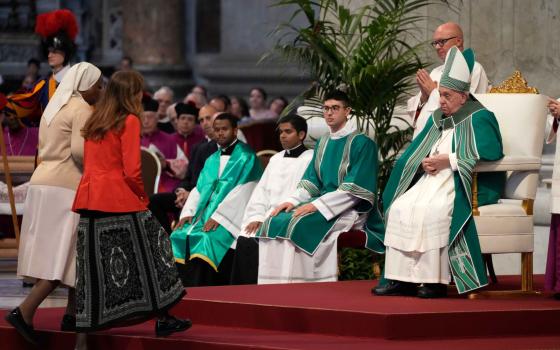
Mary of Bethany and Jesus are depicted in stained glass in Saint-Pierre de Neuilly Church in Neuilly-sur-Seine, France (Wikimedia Commons/Reinhardhauke)
This week the church celebrates the feast of Mary Magdalene, at a time when Catholicism finds itself in a definitive moment concerning the roles of women. In May, the first-ever deaconess was ordained in the Eastern Orthodox Church. Less than two weeks ago, the Vatican held a press conference announcing that the Dicastery of the Doctrine of the Faith is creating a document about women's leadership roles.
And in preparation for October's meeting of the synod on synodality, the instrumentum laboris was also released, including a pointed remark about the question of the female diaconate: "While some local Churches call for women to be admitted to the diaconal ministry, others reiterate their opposition. On this issue ... it is good that theological reflection should continue, on an appropriate timescale and in the appropriate ways."
Some have argued (understandably) that this comment reflects "delays, deferrals, further reflections, unpublished reports — while the platitudinous waffle about women's charisms and gifts drones on year after year."
As a professor at a Catholic university who was raised in the Episcopal Church, I read the situation a bit differently: I suspect that the dicastery does not know exactly what to do. Its leaders realize that the question of the role of women is urgent, but they are worried that a schism could result if women are ordained as deacons.
As the dicastery considers the possibilities, I suggest there is an avenue it hasn't looked at yet. From my expertise in manuscripts of the Gospels, I'm interested in the possibility that the Gospel of John provides a blueprint for women's roles in pastoral care and ministry, particularly in its characterization of Mary Magdalene. This sacred text may contain unique and surprising theological resources that are urgently needed in our time.
Advertisement
Throughout the history of the church, people have always wondered whether Lazarus' sister Mary is the same woman as Mary Magdalene. Several years ago, I published a study of previously overlooked manuscript variants in the story of Lazarus, and came to the conclusion that Martha, a character from Luke, might have been editorially added to this story to diminish Mary's importance (click here to see the argument in full).
Incredibly, by combining real readings from just three of the world's most important Gospel manuscripts, John 11:1-5 can be fully and sensibly reconstructed without Martha:
1 There was a certain sick man, Lazarus of Bethany, the village of Mary his sister.
2 Now this was the Mary who anointed the Lord with ointment and wiped his feet with her hair, whose brother Lazarus was sick.
3 Therefore Mary sent to him, saying, "Lord, behold, the one you love is sick."
4 But when Jesus heard he said to her, "The sickness is not unto death, but for the glory of God, so that the Son may be glorified through it."
5 Now Jesus loved Lazarus and his sister.
Martha's presence is also inconsistent in ancient artwork, as well as in the writings of church fathers; around 210 CE, Tertullian even stated that Mary was the Christological confessor of John 11:27! The obvious textual parallels between the Lazarus story and Mary Magdalene's encounter with Jesus imply that Mary of Bethany would more likely be identifiable as Mary Magdalene if Martha were not present in John.
If Martha were not present, Mary (Magdalene?) would perform five crucial ministries throughout the second half of the Gospel of John.
In a 2021 study I co-authored with professor Joan Taylor, we also demonstrated that the word "Magdalene" does not necessarily reference Mary's hometown; it could just as well be an honorific title referencing Mary as "the magnified one" or "the Tower-ess."
So, why would somebody add Martha to John's Gospel? This theorized editorial change would have ensured that in this Gospel, the woman confessing Jesus as the Christ (John 11:27) cannot be understood to be the first person to whom the risen Jesus appears (John 20:11-18). If Martha were not present, Mary (Magdalene?) would perform five crucial ministries throughout the second half of John:
- Confessing Jesus as the Christ (John 11:27);
- Serving (diakonei) the supper (John 12:2);
- Anointing Jesus for burial (John 11:2, 12:3);
- Witnessing his death and resurrection (John 19:25, 20:1, 11-17);
- Proclaiming the Resurrection (John 20:18).
Historian Diana Butler Bass argues that these five roles can be understood as a model for "Marian ministry," and through them we may be able to recover something of the evangelist's original vision for women. She and I have already submitted this proposal for the synod's consideration.
The concerns of theologians like Cardinal Raymond Burke are understandable, who worry that "a revolution is at work to change radically the church's self-understanding, in accord with a contemporary ideology which denies much of what the church has always taught and practiced." But this is not only a contemporary conversation; there are dozens of examples of women deacons in antiquity.
This "revolution" might be the work of the Holy Spirit, who surely knows whether some early Christian practices eventually became accommodated to the patriarchal values of the Roman Empire. The Gospel manuscripts highlighted above may actually contain submerged aspects of the fourth evangelist's vision for women in the church — not heresy, but perhaps simply "too much for us to bear" at that time (John 16:12).
To my eye, it looks like the Holy Spirit might be in the process of setting things straight.
A particular verse from the Lazarus story leaps out to me again and again: "This illness is not to end in death, but is for the glory of God, that the Son of God may be glorified through it" (John 11:4). Perhaps this was part of the evangelist's plan all along — an illness in the text has been allowed to stay for a time, but it is not unto death; it is to show the glory of God.
I'm just a scholar with a theory, but it seems to me that the worldwide church could be galvanized by such a restoration of Mary Magdalene. And perhaps the word of God can still pierce through the ages in a way that is bigger than we ever imagined.






